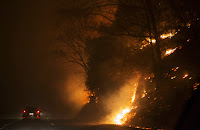What appears to be the most damaging wildland fire to strike a Southeast U.S. community in many decades tore into the tourist mecca of Gatlinburg, Tennessee, on Monday night. The Chimney Top Fire has burned hundreds of structures in and near this much-loved city and has injured at least four people. Nearby Pigeon Forge, home of the Dollywood theme park, has also been affected by the fire, which began in the adjacent Great Smoky Mountains. At least 14,000 people were evacuated from the area, and an estimated 1000-plus people were in shelters on Tuesday morning.
...
Unfortunately, the Gatlinburg fire may be a harbinger of increased fire risk across the Southeast in the decades to come, as suggested by the U.S. National Climate Assessment. A 2015 study led by Renaud Barbero (University of Idaho) suggests that the number of week-long periods with very large fires over the southern and central Appalachians may double by the 2040s - 2060s as a result of climate change. Population growth is also adding to the region’s risk. As more people move to the fringes of towns and cities, more than half of the nation’s wildland-urban interface is now located within the Southeast.
Gatlinburg is the second catastrophic wildfire this year to strike a sizable North American community in an unexpected fashion. It follows the disastrous blaze that swept across Fort McMurray, Canada, in early May, after record-setting mid-spring temperatures close to 90°F came on the heels of a very early snowmelt. The Fort McMurray fire was the costliest disaster in Canadian history, with more than $3 billion US in damage. As I wrote in a post on that event: “We have much more to learn about exactly why and how the atmosphere is moving in directions that favor devastating fire--but for now, perhaps it’s enough simply to know that the dice are being loaded. Together with the many other threats posed by climate change, this should be more than enough motivation to get serious about emission cuts. The vast and profound effects of human-produced greenhouse gases--from intensified downpours and drought impacts to ocean acidification and sea-level rise--call for a sustained commitment to change that transcends any single disaster.”
Read more at Catastrophic Fire Hits Southeast Tennessee Homes and Resorts

No comments:
Post a Comment